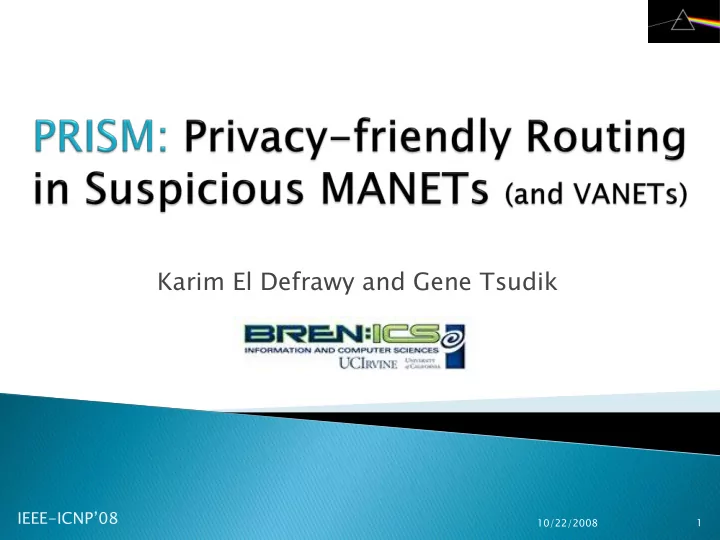

Karim El Defrawy and Gene Tsudik IEEE- ICNP’08 10/22/2008 1
Introduction Privacy and Security in MANETs Related Work ◦ Overview of Group Signatures PRISM ◦ Protocol and Operation ◦ Security Analysis and Simulations Future Work and Conclusion IEEE- ICNP’08 10/22/2008 2
Infrastructure-less Mobile Multitude of devices and capabilities May be deployed in extreme settings (e.g. military, search and rescue) IEEE- ICNP’08 10/22/2008 3
Environment is “hostile” and “suspicious” ◦ Military/battlefield: infantry, naval- and air-craft ◦ Law enforcement: sting operations, attack/disaster aftermath IEEE- ICNP’08 10/22/2008 4
Special type of MANETs Restricted mobility (highways and roads) High speeds Privacy is a must IEEE- ICNP’08 10/22/2008 5
Goal: ◦ Tracking resistance no exposure of long-term IDs ◦ Escrowed Anonymity only certain authorized entities (e.g. law enforcement) can learn long-term ID Challenges: ◦ How to authenticate if no long-term ID? ◦ How to achieve integrity, accountability in case of misbehavior? ◦ Malicious insiders become harder to combat IEEE- ICNP’08 10/22/2008 6
Typical security requirements: ◦ Confidentiality ◦ Integrity ◦ Authentication ◦ Accountability and non-repudiation Main difficulty when coupled with privacy requirements IEEE- ICNP’08 10/22/2008 7
Secure on-demand routing protocols: Ariadne, SRDP, SEAD, EndairA , SRP… (no privacy) Privacy preserving on demand protocols: ANODR, MASK, D- ANODR, ARM, ODAR… ◦ All use identity-centric communication ◦ All require either: Long Term ID or pseudonyms Source shares information/keys with destination (ASR,ARM,ASRP,ANODR) Source knows public key of destination (SDAR) Online location/certificate servers (SPAAR, AO2P,ODAR) ◦ Not location based IEEE- ICNP’08 10/22/2008 8
◦ ALARM (ICNP’07) – privacy-preserving link state-based (proactive) routing protocol Optimized Link State Routing (OLSR) is closest to ALARM but without privacy and security ◦ Location-aided forwarding scheme (e.g., LAR, GeoGrid …etc) IEEE- ICNP’08 10/22/2008 9
Location-centric communication instead of identity-centric more suitable in certain MANETs (VANETs) settings. Location-centric communication more privacy- friendly Group signatures used to construct privacy- preserving and secure on-demand MANETs routing protocol (PRISM) PRISM is based on AODV IEEE- ICNP’08 10/22/2008 10
Any member of a potentially large and dynamic group can sign a message (produce a GSIG) GSIG can be verified by anyone who has a constant- length group public key Valid signature signer is a group member Given two GSIGs, it is computationally infeasible to determine if produced by same member In the event of a dispute, a GSIG can be opened by off-line authority to reveal actual signer IEEE- ICNP’08 10/22/2008 11
SETUP: an algorithm run by GM: ◦ input: security parameter k ◦ output: cryptographic specification of group, GM public ( pkGM ) and private keys ( skGM ) JOIN: a protocol between GM and user resulting in user becoming a member ( U ) and having a public/private key ( pkU,skU) . SIGN: an algorithm executed by a group member: ◦ input: message (m), group public key ( pkGM ) , member public/private key ( pkU,skU) ◦ output: GSIG= δ of m IEEE- ICNP’08 10/22/2008 12
VERIFY: an algorithm run by anyone: ◦ input: message ( m ), GSIG ( δ ), group public key ( pkGM ) ◦ output: binary flag indicating validity of GSIG OPEN: an algorithm run by the GM: ◦ input: message ( m ), GSIG ( δ ), group public key ( pkGM ), GM secret key ( skGM ) ◦ output: validity of signature, identity of signer ( pkU ), a proof that allows anyone to verify identity of signer REVOKE: an algorithm run by GM to remove (revoke a user from the group) IEEE- ICNP’08 10/22/2008 13
Group Manager (GM): entity responsible for administering the group. Has private key and the group public key. Group Members: users/entities that represent the current set of authorized signers. Each has a public/private key and the group public key. Outsiders: any other user/entity external to group. Has group public key. IEEE- ICNP’08 10/22/2008 14
[LOCATION] nodes can obtain location info (e.g., GPS) [PRIVACY] no long-term public node ID or address [MOBILITY] network is mobile but nodes are loosely synchronized (e.g., using GPS) [SECURITY] ◦ Outside attackers ◦ Passive (honest-but-curious) insiders IEEE- ICNP’08 10/22/2008 15
GM sets up the GSIG scheme 1. Nodes join the group with GM and generate 2. keys and get the group public key MANET deployment 3. IEEE- ICNP’08 10/22/2008 16
PR PRISM SM Ope peration ration IEEE- ICNP’08 10/22/2008 17
PR PRISM SM Ope peration ration IEEE- ICNP’08 10/22/2008 18
PR PRISM SM Ope peration ration IEEE- ICNP’08 10/22/2008 19
PR PRISM SM Ope peration ration IEEE- ICNP’08 10/22/2008 20
PR PRISM SM Ope peration ration IEEE- ICNP’08 10/22/2008 21
PR PRISM SM Ope peration ration IEEE- ICNP’08 10/22/2008 22
PR PRISM SM Ope peration ration IEEE- ICNP’08 10/22/2008 23
Active/Passive Outsiders: ◦ Records, replays and/or injects routing messages Replay attacks prevented due to RREQ/RREP time- stamps Injecting or modifying messages requires producing genuine GSIGs (computationally infeasible) IEEE- ICNP’08 10/22/2008 24
Passive (honest-but-curious) Insider: ◦ Eavesdrops to track peer nodes Can't link multiple messages to same node (computationally infeasible to link GSIGs) Can track node movement by monitoring likely trajectories (but need lots of topology knowledge) Sees less topology than in link-state protocols (simulation) IEEE- ICNP’08 10/22/2008 25
Active Insiders: ◦ PRISM is not secure against active insiders in real- time ◦ Active insiders can lie about their locations and create phantom nodes (does not hurt privacy) ◦ Can be detected off-line by GM IEEE- ICNP’08 10/22/2008 26
Two mobility models: ◦ RWM (Random Waypoint) ◦ RPGM (Reference Point Group Mobility) DST-AREA radius = 20m Area = 1000m2 Tx-Range=150m Num Nodes= 1000 50 sending sources IEEE- ICNP’08 10/22/2008 27
One-time certificates instead of GSIG (scalability issues) Prevent active insiders based on location information and directions of RREQ Accommodate heterogeneous MANET devices (i.e. no GPS and GSIG capability) Evaluation with real mobility traces IEEE- ICNP’08 10/22/2008 28
IEEE- ICNP’08 10/22/2008 29
Location-centric communication is more privacy friendly Group signatures are a promising building block for privacy-preserving secure protocols Several research problems remain IEEE- ICNP’08 10/22/2008 30
IEEE- ICNP’08 10/22/2008 31
IEEE- ICNP’08 10/22/2008 32
Recommend
More recommend